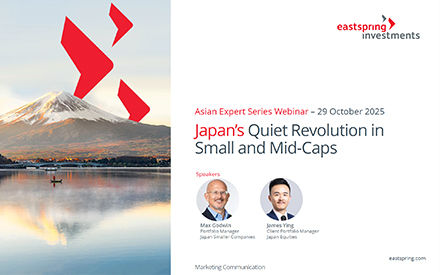Summary
Initial public offerings and share placements continue to appeal as funding options for companies in Asia Pacific. Equally, new growth sectors, increasing populations, and market reforms will serve to underpin the region’s momentum in deal flows.
Equity capital markets play a critical role in a country’s economic development. As of June 2023, the US equity market is the largest by market capitalisation globally, with a 43% share, followed by Europe (11%), China (~11%) and Japan (5%)1
In Asia, as the region’s economies developed and expanded over time, so too have their capital markets; in 2010, total capitalisation across key Asian markets was nearly USD15 trillion, which doubled to USD30 trillion by 2022. Fig 1. More importantly, proceeds from Asia Pacific’s Initial Public Offerings (“IPOs”) also exceeded the Americas in 2022, the first time since 2018, with 802 IPOs raising USD108 billion. But with Asia expected to account for over 40% of the world’s GDP by 20302, the region’s capital markets need to expand and develop further to facilitate long-term growth.
Fig 1: Asian markets’ capitalisation
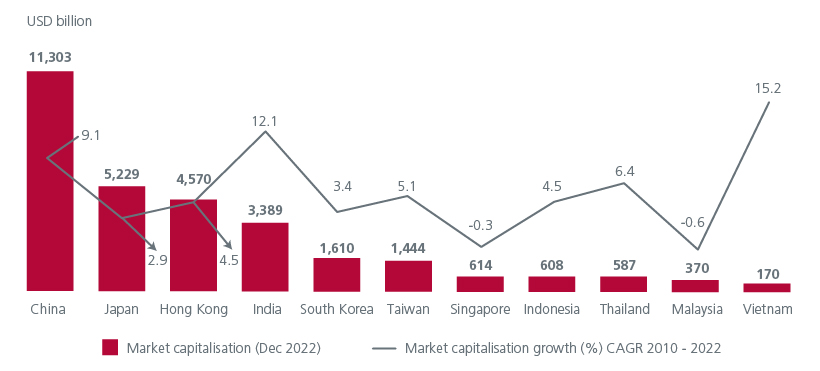
Source: CEIC, NSE Dec 2022
Asia Pacific maintains its IPO lead
Despite accounting for less than 20% of the MSCI All Country World index, Asia Pacific makes up the majority of global IPOs. Fig 2. Between 2007 and 2022, there have been over 1,180 IPOs. As at 1H2023, Asia Pacific continues to be the global leader in IPO volume and value, but uncertainty over interest rates and economic conditions resulted in a 2% decrease in the number of IPOs compared to 1H2022. Still half of the top ten global IPOs were from Mainland China, and one was from Japan. In terms of sectors, technology, industrials, and materials were the major issuers.3
Fig 2: Asia’s share of global IPOs
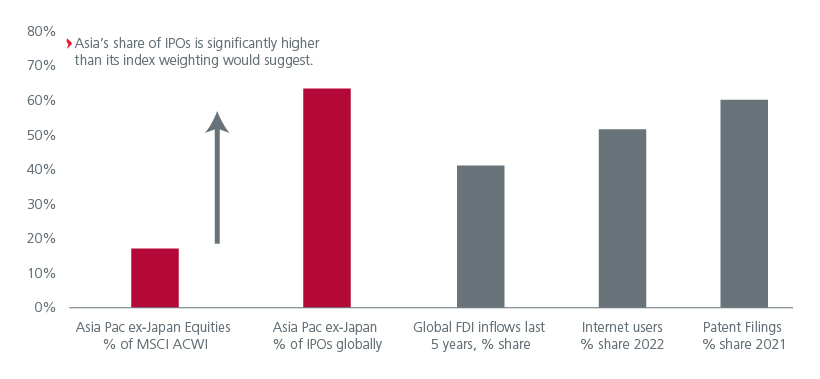
Source: Eastspring Investments (Singapore) Limited; All data refer to Asia Pacific ex Japan region as a % share; MSCI ACWI Index is a global equity index designed by MSCI to represent the full set of large and mid-cap stocks across 23 developed and 24 emerging markets, data as of 31st Dec 2022; IPO data from JP Morgan for 2022; World Bank FDI inflow data from 2017 to 2021; Internet user data from Statista for 2022; “WIPO World Intellectual Property Indicators 2022”, data for patent filings in 2021.
Meanwhile India recorded 80 new IPO listings, driven by small and medium enterprises coming to the market, an increase of 33% over 1H2022. India has continued to increase its global IPO share and currently commands roughly 13% of the market. Interestingly, ASEAN has seen a pickup in activity as well, recording more IPOs in the first half of 2023 than in any of the previous five years. Indonesia has been a star performer, especially with the materials sector, which is focused on the green energy transition, being at the forefront of market activity.
It is vital to note that the Asia Pacific ex-Japan region has seen a continuous deal flow for IPOs through various economic cycles, offering investors exposure to a good mix of sectors and countries throughout. Fig 3. In addition, even in the years with fewer IPO deals, there has been a continuous flow of follow-on offerings and blocks.
Fig 3: IPO opportunities through good and bad times
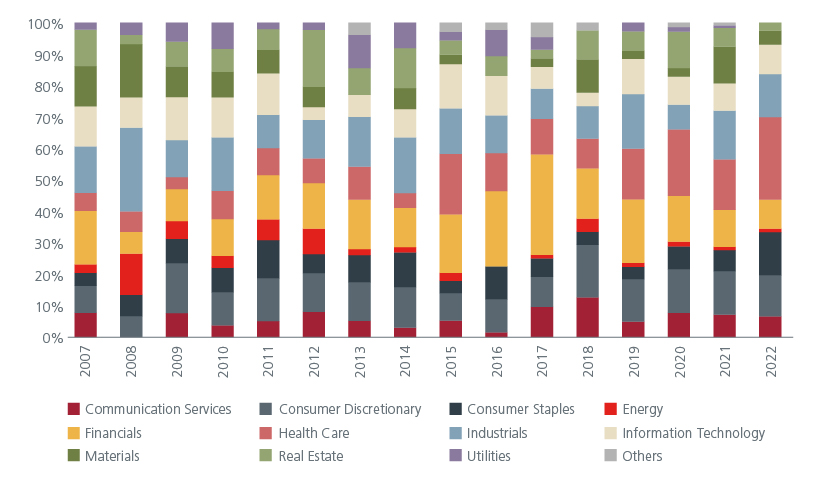
Source: Eastspring Investments (Singapore) Limited. IPO Data from 1 January 2007 to 31st December 2022 using the using Bloomberg data. Chinese A-share IPOs are excluded given market access limitations via Stock Connect for initial public offerings. Only IPOs with at least USD 500 million market capitalization and USD 0.8 million USD 3-month average daily value traded are included in the data
Share placements offer another avenue
While IPOs are considered significant events for both corporates and investors to gain access to equity capital markets, placements offer similar access opportunities. For example, a publicly listed company can turn to the market via follow-on offerings when in need of primary capital to finance investments. Block trades are also conducted by large institutional investors to acquire or dispose of shares in listed companies, and these trades can often come at attractive discounts.
Between 2007 and 2022, there have been an average of 309 follow-ons and blocks. Fig 4. Irrespective of market cycles, the market for these deals again has seen a continuous flow, ranging from a low of 105 placements in 2008 to a peak of 491 placements in 2021.
Fig 4: Number of follow-ons and blocks
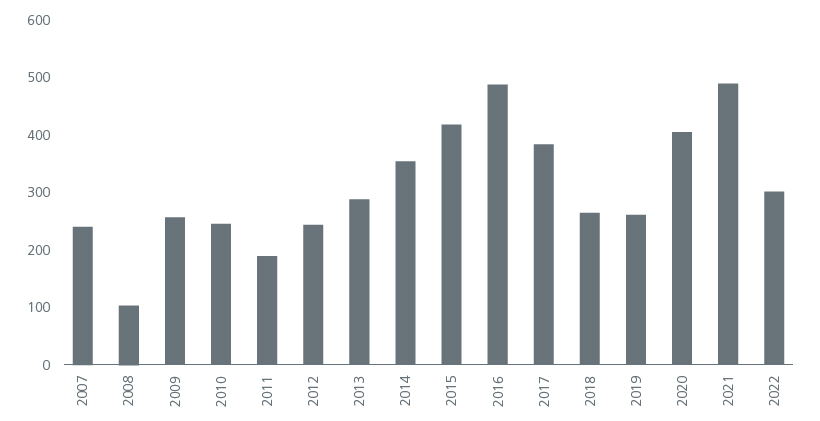
Source: Eastspring Investments (Singapore) Limited. Data regarding follow-ons and blocks from Dealogic database up until 31st December 2022, transactions from 1 Jan 2007 to until 31st December 2022. Follow-ons includes Primary Offerings such as Equity follow-ons, Rights Offerings and Topups. Blocks includes Secondary sell downs by existing shareholders (by hiring a third-party intermediary like an investment bank and launching a block sale process with a term sheet to the market). Data is screened for Asia Pacific ex Japan universe.
The growing market of retail investors
The increased participation of retail investors is another trend that has been ongoing for a while, thanks in part to the introduction of financial technology solutions. Online investment platforms, robo-advisors, and other digital innovations are enabling retail investors easier access to trade and participate in more markets. The retail investors of today often take greater ownership of their financial affairs and are motivated to grow their wealth to meet their own financial goals. Rising affluence is yet another factor fuelling the retail investing trend, and Asia’s growing middle class supports this development.
Historically, IPOs have also appealed to the retail investor for its alpha generation potential. Our analysis shows that IPOs historically demonstrate positive excess returns over the market. Analysis around the “first day IPO pop” shows consistent positive first-day excess returns going back 15 years. Fig 5. We see a similar phenomenon when looking at longer-term excess returns from participating in IPOs for the same markets. One thing to take note is that retail investors usually cannot directly participate in IPOs in markets outside of their home country. One way around this is to invest in mutual funds that have access to equity capital market events across geographies.
Fig 5: First-day index-adjusted* returns by year for IPOs

Source: Eastspring Investments (Singapore) Limited. IPO: initial public offering. *IPO Data from 1 January 2007 to 31st December 2022. Chinese A-share IPOs are excluded given market access limitations via Stock Connect for initial public offerings. Index used is the MSCI Asia Pacific ex Japan Index. The returns shown are index adjusted median returns using Bloomberg Data, screened for companies with at least $500m market capitalization at listing. Past IPO returns are not necessarily indicative of future returns.
The region’s long-term potential
Asia remains a high growth region led by two of its largest emerging economies, China and India. Rapid economic progress has resulted in both countries having their weights raised in the regional indices. This trend is expected to continue in the medium term, driven by further A-share inclusion (China) and more equity capital market deals in both markets.
Besides these two giants, other countries in the region also possess attractive growth traits that will be supportive of more deal activity. For example, the region’s increasingly urban and middle-class consumer will spur more IPOs in sectors related to consumer demand i.e., digital infrastructure, technology, and fintech. Meanwhile climate change is hastening the move to renewables. The energy transition is creating huge disruptions in some sectors, resulting in new business opportunities. In fact, Indonesia’s star IPO performance to date is driven by its ample battery metal reserves which are critical for electric vehicles.
There is also the trend of companies adopting the China plus one strategy in the wake of COVID-19 supply chain disruptions and ongoing geopolitical tensions. ASEAN and India are clear beneficiaries, and this shift is expected to further underpin the region’s growth.
Supportive backdrop bodes well
Some of the key reasons for choosing to list and trade on an exchange include costs, liquidity, and listing rules. To this end, Asian bourses have in recent times implemented supportive policies to facilitate both issuer and investor market access. India’s capital markets regulator has recently proposed to reduce timelines for IPOs from six days to three days. Likewise, China has relaxed the rules for IPO listings which should speed up listings and corporate fundraising. The Hong Kong and Beijing bourses also recently agreed to let qualified companies apply for a dual listing on each other’s bourses.
Looking ahead, the region’s capital expenditure needs are rising given population growth, climate change investments, and the re-routing of global supply chain ecosystems. The capex boom will invariably result in more equity capital market deals. The region’s financial markets will play a vital role in financing these needs and allocating capital to productive projects. And with investors anticipating the end of rate hikes, conditions should become conducive for a more buoyant market with ample primary and secondary offerings in the years ahead.
Sources:
1
World Federation of Exchanges, SIFMA estimates, June 2023
2 Fitch Solutions, 2022
3 https://www.ey.com/en_sg/ipo/trends, June 2023
The information and views expressed herein do not constitute an offer or solicitation to deal in shares of any securities or financial instruments and it is not intended for distribution or use by anyone or entity located in any jurisdiction where such distribution would be unlawful or prohibited. The information does not constitute investment advice or an offer to provide investment advisory or investment management service or the solicitation of an offer to provide investment advisory or investment management services in any jurisdiction in which an offer or solicitation would be unlawful under the securities laws of that jurisdiction.
Past performance and the predictions, projections, or forecasts on the economy, securities markets or the economic trends of the markets are not necessarily indicative of the future or likely performance of Eastspring Investments or any of the strategies managed by Eastspring Investments. An investment is subject to investment risks, including the possible loss of the principal amount invested. Where an investment is denominated in another currency, exchange rates may have an adverse effect on the value price or income of that investment. Furthermore, exposure to a single country market, specific portfolio composition or management techniques may potentially increase volatility.
Any securities mentioned are included for illustration purposes only. It should not be considered a recommendation to purchase or sell such securities. There is no assurance that any security discussed herein will remain in the portfolio at the time you receive this document or that security sold has not been repurchased.
The information provided herein is believed to be reliable at time of publication and based on matters as they exist as of the date of preparation of this report and not as of any future date. Eastspring Investments undertakes no (and disclaims any) obligation to update, modify or amend this document or to otherwise notify you in the event that any matter stated in the materials, or any opinion, projection, forecast or estimate set forth in the document, changes or subsequently becomes inaccurate. Eastspring Investments personnel may develop views and opinions that are not stated in the materials or that are contrary to the views and opinions stated in the materials at any time and from time to time as the result of a negative factor that comes to its attention in respect to an investment or for any other reason or for no reason. Eastspring Investments shall not and shall have no duty to notify you of any such views and opinions. This document is solely for information and does not have any regard to the specific investment objectives, financial or tax situation and the particular needs of any specific person who may receive this document.
Eastspring Investments Inc. (Eastspring US) primary activity is to provide certain marketing, sales servicing, and client support in the US on behalf of Eastspring Investment (Singapore) Limited (“Eastspring Singapore”). Eastspring Singapore is an affiliated investment management entity that is domiciled and registered under, among other regulatory bodies, the Monetary Authority of Singapore (MAS). Eastspring Singapore and Eastspring US are both registered with the US Securities and Exchange Commission as a registered investment adviser. Registration as an adviser does not imply a level of skill or training. Eastspring US seeks to identify and introduce to Eastspring Singapore potential institutional client prospects. Such prospects, once introduced, would contract directly with Eastspring Singapore for any investment management or advisory services. Additional information about Eastspring Singapore and Eastspring US is also is available on the SEC’s website at www.adviserinfo.sec. gov.
Certain information contained herein constitutes "forward-looking statements", which can be identified by the use of forward-looking terminology such as "may", "will", "should", "expect", "anticipate", "project", "estimate", "intend", "continue" or "believe" or the negatives thereof, other variations thereof or comparable terminology. Such information is based on expectations, estimates and projections (and assumptions underlying such information) and cannot be relied upon as a guarantee of future performance. Due to various risks and uncertainties, actual events or results, or the actual performance of any fund may differ materially from those reflected or contemplated in such forward-looking statements.
Eastspring Investments companies (excluding JV companies) are ultimately wholly-owned / indirect subsidiaries / associate of Prudential plc of the United Kingdom. Eastspring Investments companies (including JV’s) and Prudential plc are not affiliated in any manner with Prudential Financial, Inc., a company whose principal place of business is in the United States of America.









